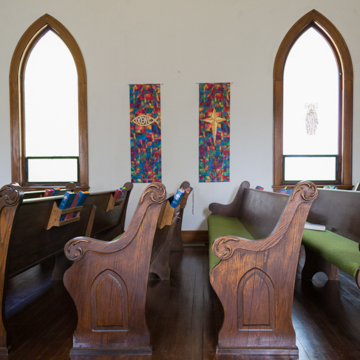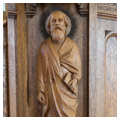You are here
St. Peder’s Evangelical Lutheran Church
St. Peder’s Dansk Evangelical Lutheran Kirke, as it was originally called, is located in the very small, unincorporated village of Nysted. Named for a town in Denmark, Nysted lies within Howard County, one of the first areas of Danish settlement in Nebraska. Both the village and the church were established in the early 1880s. In 1921 the current church replaced the Danish community’s first church, a wood-framed structure built in 1887. Its design is typical of Danish village churches and incorporates the traditions of fifteenth- and sixteenth-century Danish ecclesiastical architecture.
The building is a one-story brick structure over a raised basement. Rectangular in plan, the nave and chancel are covered by a gable roof with the central entrance located under a square bell tower. That tower, along with the other facades, features engaged buttresses. The pointed arch windows have concrete caps. The stepped brick gables on the ends of the nave and chancel and on the four sides of the bell tower link the church to its Danish architectural precedents. The modest interior features a ceiling and sanctuary walls that are unadorned except for the wooden arch that frames the chancel. Noteworthy appointments include the hand-carved pulpit and altar, the latter displaying a stepped design that mimics the characterizing exterior feature of the church.
This church, along with the Danish Folk School (1888–1937) located across the street, forms an integral part of Danish cultural heritage in Nysted.
References
Christensen, Marjorie, Barbara Sorensen, and Jill Dolberg, “St. Peder’s Evangelical Lutheran Church,” Howard County, Nebraska. National Register of Historic Places Registration Form, 2006. National Park Service, U.S. Department of the Interior, Washington, DC.
Writing Credits
If SAH Archipedia has been useful to you, please consider supporting it.
SAH Archipedia tells the story of the United States through its buildings, landscapes, and cities. This freely available resource empowers the public with authoritative knowledge that deepens their understanding and appreciation of the built environment. But the Society of Architectural Historians, which created SAH Archipedia with University of Virginia Press, needs your support to maintain the high-caliber research, writing, photography, cartography, editing, design, and programming that make SAH Archipedia a trusted online resource available to all who value the history of place, heritage tourism, and learning.



















